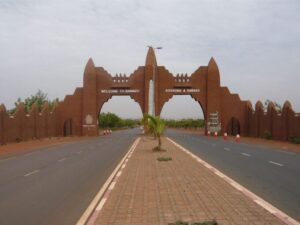Russia vs NATO. How Mali became another front for the Ukraine war. France massacring civilians like Ukraine is doing in Donbas using French supplied illegal cluster shells..
Tue 9:26 am +01:00, 14 Jun 2022
The distance between Ukraine and Mali is measured in thousands of kilometers. But the geopolitical distance is much closer to the point that it appears as if the ongoing conflicts in both countries are the direct outcomes of the same geopolitical currents and transformation underway around the world.
The Malian government is now accusing French troops of perpetuating a massacre in the West African country. Consequently, on April 23, the Russian Foreign Ministry declared its support for Malian efforts, pushing for an international investigation into French abuses and massacres in Mali. “We hope that those responsible will be identified and justly punished,” the Ministry said.
In its coverage, Western media largely omitted the Malian and Russian claims of French massacres; instead, they gave credence to French accusations that the Malian forces, possibly with the help of ‘Russian mercenaries’ have carried out massacres and buried the dead in mass graves near the recently evacuated French army Gossi base, in order to blame France.
Earlier in April, Human Rights Watch called for an ‘independent, credible’ inquiry into the killings, though it negated both accounts. It suggested that a bloody campaign had indeed taken place, targeting mostly “armed Islamists” between March 23-31.
Media whitewashing and official misinformation aside, Mali has indeed been a stage for much bloodletting in recent years, especially since 2012, when a militant insurgency in Northern Mali threatened the complete destabilization of an already unstable and impoverished country.
There were reasons for the insurgency, including the sudden access to smuggled weapon caches originating in Libya following the West’s war on Tripoli in 2011. Thousands of militants, who were pushed out of Libya during the war and its aftermath, found safe havens in the largely ungoverned Malian northern regions.
That in mind, the militants’ success – where they managed to seize nearly a third of the country’s territory in merely two months – was not entirely linked to western arms. Large swathes of Mali have suffered from prolonged governmental neglect and extreme poverty. Moreover, the Malian army, often beholden to foreign interests, is much hated in these regions due to its violent campaigns and horrific human rights abuses. No wonder why the northern rebellion found so much popular support in these parts.
Two months after the Tuareg rebellion in the north, a Malian officer and a contingency of purportedly disgruntled soldiers overthrew the elected government in Bamako, accusing it of corruption and of failure in reining in the militants. This, in turn, paved the road for France’s military intervention in its former colony under the guise of fighting terrorism.
The French war in Mali, starting in 2013, was disastrous from the Malians’ point of view. It neither stabilized the country nor provided a comprehensive scheme on how to pacify the rebellious north. War, human rights violations by the French themselves, and more military coups followed, most notably in August 2020 and May 2021.
But France’s intervention was fruitful from France’s viewpoint. As soon as French troops began pouring into Mali, as soon as France began strengthening its control over the Sahel countries, including Mali, leading to the signing of two defense agreements, in 2013 and 2020.
That’s where the French West African ‘success story’ ends. Though Paris succeeded in digging its heels deeper in that region, it gave no reason to the Malian people or government to support their actions. As France became more involved in the life of Malians, ordinary people throughout the country, north and south, detested and rejected them. This shift was the perfect opportunity for Russia to offer itself as an alternative to France and the West. The advent of Russia into the complex scene allowed Bamako to engineer a clean break from its total reliance on France and its Western, NATO allies.
Even before France formally ended its presence in the country, Russian arms and military technicians were landing in Bamako. Attack helicopters, mobile radar systems and other Russian military technology quickly replaced French arms. It is no wonder why Mali voted against the United Nations General Assembly Resolution to suspend Russia from the UN Human Rights Council.
As a result of the Ukraine war and western sanctions starting in late February, Russia accelerated its political and economic outreach, particularly in southern countries, with the hope of lessening the impact of the west-led international isolation.
In truth, Moscow’s geopolitical quest in West Africa began earlier than the Ukraine conflict, and Mali’s immediate support for Russia following the war was a testament to Moscow’s success in that region.
Though France officially began its withdrawal from Mali last February, Paris and other European capitals are increasingly aware of what they perceive to be a ‘Russian threat’ in that region. But how can the West fight back against this real or imaginary threat, especially in the light of the French withdrawal? Further destabilizing Mali is one option.
Indeed, on May 16, Bamako declared that it thwarted a military coup in the country, claiming that the coup leaders were soldiers who “were supported by a Western state”, presumably France.
If the ‘coup’ had succeeded, does this indicate that France – or another ‘western country’ – is plotting a return to Mali on the back of yet another military intervention?
Russia, on the other hand, cannot afford to lose a precious friend, like Mali, during this critical time of western sanctions and isolation. In effect, this means that Mali will continue to be the stage of a geopolitical cold war that could last for years. The winner of this war could potentially claim the whole of West Africa, which remains hostage to global competition well beyond its national boundaries.
JUNE 9, 2022
Photograph Source: Rgaudin – Public Domain

https://www.counterpunch.org/2022/06/09/russia-vs-nato-how-mali-became-another-front-for-the-ukraine-war/?fbclid=IwAR2–GwD_2Nmvn9J_d8PYlZbgUs7s2ATBgIKyHidOPJymVMbnvl4Pbq-RTA










